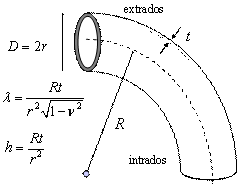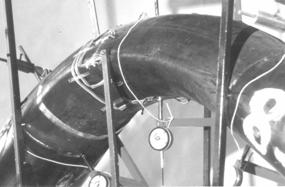Numerical Simulation of Mechanical Behavior of Industrial Elbows
by Patricia Pappa
Graduate Diploma Thesis, November 2008
ABSTRACT
Curved pipe segments are widely used in pipelines and industrial piping. Because of the importance for safeguarding their structural integrity, much research has been devoted to the study of their mechanical behavior. It is well-know that the behavior of a tubular member under bending loads is characterized by a significant distortion of the cross-section. This distortion, often referred to as "ovalization" or "Brazier" effect, makes the tube more flexible and produces additional stresses, which need to be considered in analysis and design. This phenomenon is more pronounced in curved pipes, referred to as "elbows". Regular beam elements are inadequate to predict such a behavior, whereas the use of shell elements is often computationally expensive. The need for simple and efficient simulation of mechanical behavior of curved pipes has motivated the development of special-purpose elements, referred to as "pipe" or "elbow" or "tube" elements, as alternatives to shell elements. Those elements have been shown to be quite effective for modeling pipelines, elbows and piping systems. Among other advantages of those elements over shell elements, "pipe" elements more convenient to apply boundary conditions and appropriate kinematic constraints. Furthermore, the results from tube elements are more easily interpreted, in terms of longitudinal bending or cross-sectional distortion.
In the present study, the development of a family of continuum-type tube elements is described. The elements are aimed at providing simple and efficient stress analysis of pipes and elbows towards a reliable engineering design. A three-node version of the ''tube element'' was first developed by Karamanos and Tassoulas (1996) for the nonlinear analysis of relatively thick inelastic tubes. Later this element was employed for the buckling analysis of thin-walled elastic cylinders. Herein, a family of such elements is developed and tested in standard benchmark problems, in terms of their accuracy and computational efficiency.
For each element of the proposed element family (2-node, 3-node, 4-node), a series of studies are conducted to determine its optimum behavior. The basic issues to be examined are the number of cross-sectional parameters and the number of integration points in the three directions within the pipe. Several benchmark problems are used towards this purpose. Comparisons are made with analytical solutions and shell-elements, in terms of the corresponding strain and stress distributions. Finally, a comparison with available experimental data from TNO, the Netherlands, is also conducted.


Figure 1